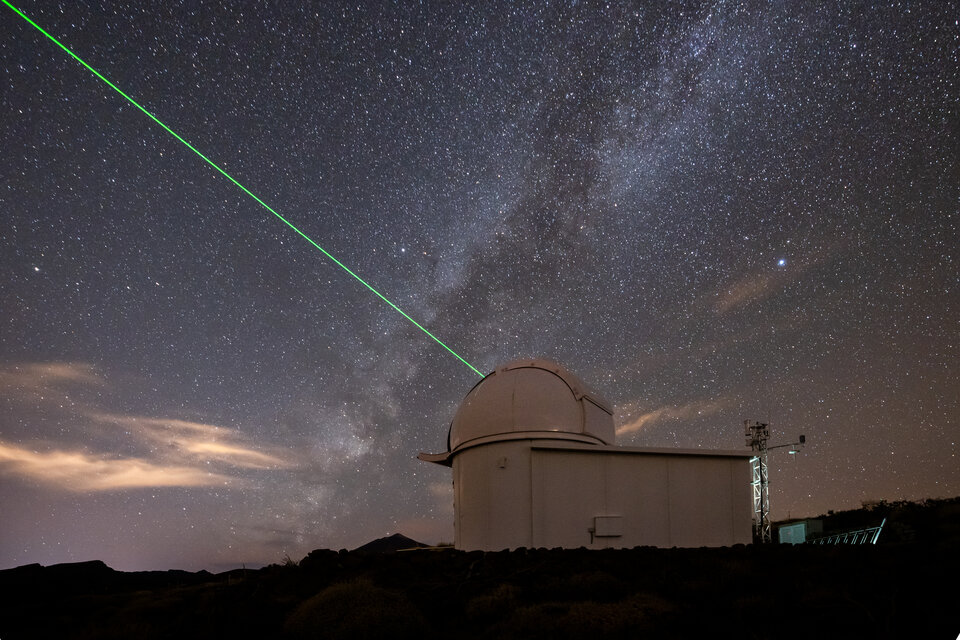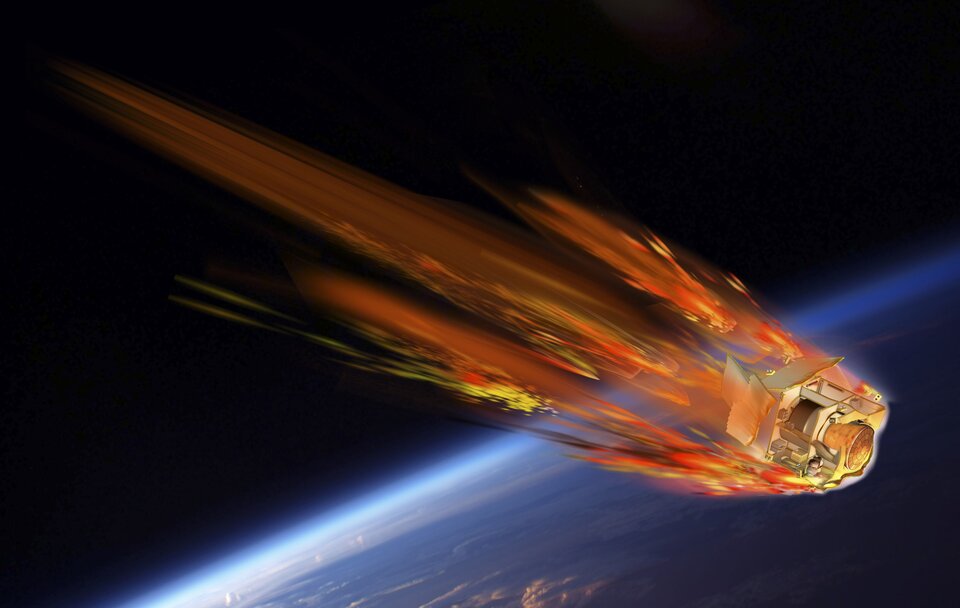Space Debris Projects and Core Activities - CM22
VISDOMS
VISDOMS (Verification of In-Situ Debris Optical Monitoring from Space) with its Space-Based Optical Component (SBOC) has the primary mission objective to demonstrate statistical monitoring of sub-catalogue, small objects down to one millimetre in diameter in low-Earth orbit and beyond. The secondary objective is to demonstrate geostationary surveillance from satellites in low-Earth orbit.
The passive optical telescope, which will have a wide FOV of about 3deg x 3deg shall be flown on a dedicated micro-satellite (~150 kg total mass) or as hosted payload on a third-party satellite, ideally in an 6h to 8h SSO orbit at about 700km altitude or lower. The nominal lifetime of the full mission would be less than 5 years. This concept of small-scale debris characterisation from low-Earth orbit has already been developed and the next goal is to launch a hosted payload in 2026 and launch the mission in 2030.
For Period 2 of Space Safety Programme, the following activities are envisaged: concept demonstration through the implementation of a hosted payload mission, and the Phase A/B mission study up to System Requirements Review and Preliminary Design Review of a dedicated mission to be launched.
The similarities of the anticipated dawn-dusk orbits for optical debris monitoring and the Auroral imaging offer the opportunity to explore the synergies between VISDOMS and Aurora-D. Two options have been identified: 1) implementation as common demonstration mission with the Auroral Imagers and SBOC on the same platform, or 2) single procurement of two satellites with dedicated instruments for VISDOMS and Aurora-D, and potentially shared launch, ground segment, and satellite operation.
LMT – LASER TECHNOLOGY

The objectives of the LMT (Laser-based Momentum Transfer) project are to demonstrate momentum transfer through ground-based lasers and to further advance laser networking technologies and technology transfer from ESA’s laser-ranging testbed to national systems. The first focus is to advance precise laser tracking of debris with existing lasers to reduce position uncertainties in collision avoidance and therefore leading to cost savings, and laser-based momentum transfer (LMT), which increases mission safety due to “nudging” no-manoeuvrable space debris, which is also leading to cost savings.
Engineering studies for laser momentum transfer recommend a full system consisting of ten LMT stations in a network, starting with the development of an engineering station. Once the engineering station will be on-site, the following steps are envised: SLR installation to engineering station, installation of a Laser Guide Star for LEO objects, momentum transfer laser (design target ~40kW continuous wave), full system integration and test of SLR and laser guide star assisted laser momentum transfer followed by demonstration.
During the Space Safety Programme Period 2 key steps on the preparation of the laser momentum transfer engineering LMT should be completed by addressing identified technology gaps in a phase A/B1 system design, such as:
* Specular back reflection of irradiated debris (air traffic safety)
* Thermal stability of space debris and heating
* Legal, regulatory and export control aspects including dual use technology
* Weather analysis for network availability and site selection
* Risk reduction of high-power lasers and their absolute pointing stability for LMT. Finalise demonstration of support technology via ESA’s LRS (such as daylight tracking, precise mounts, handover technology)
* Prepare the development of moving laser guide star and laser tracking adaptive optics for momentum transfer
* Identify suitable existing infrastructure for implementation Step 1 and Step 2
* Prepare for demonstration of LMT using CubeSats in formation, continuation and launch in Period 3.
DRACO

The DRACO (Destructive Re-entry Assessment Container Object) mission is a debris re-entry experiment whose main goal is to measure the representative break-up of a spacecraft in the space environment with a small platform and demonstrate prototyped re-entry safety applications. A dedicated flight experiment will reduce uncertainties in the breakup and demise processes. The physics of the destructive break-up process of large space objects in the earth atmosphere is poorly understand so far. Ground-experimentation is limited in size and not fully representative. Whereas remote and in-situ observations are beyond rudimentary predictive capabilities. DRACO experiment will transmit data directly and be the world's first demonstration of a controlled break-up process to extrapolate ground test to flight. The mission objectives assume the representative satellite platform of about 150kg on a controlled re-entry trajectory (max 4 days in orbit) instrumented to record destructive break-up. Mission is planned to be launched in 2027 on the Ariane 6/Vega baseline or any credible European micro launcher. The system need to include the instrument calibration for break-up events such as visual and IR cameras, wind tunnel sensors, direct instrumentation within S/C, connected to survivable capsule.
CREAM

The objective of CREAM (Collision Risk Estimation and Automated Mitigation) is to demonstrate a ‘decision support system’ for collision avoidance manoeuvres, the integration and deployment of a pilot for automated and secure exchange of spacecraft manoeuvre plans and enhancement of autonomous decisions. The expansion of the envelope for autonomous decisions will increase the robustness and cover low relative velocity encounters, continuous and/or autonomous orbit control (low thrust/drag control), maturation of collision avoidance during early operations and initial orbit acquisition campaigns. Means to assess the quality of operator data will be required. A demonstration will be possible through, e.g., an expert facility to support data fusion in the risk assessment process. In CREAM it is proposed to further define decision criteria beyond collision probability, e.g. by considering environment indexes or capacity metrics.
The considered demonstration is a piggy-back mission on an existing small satellite to verify the building blocks of CREAM technology, e.g., late access and on-board autonomy. Preparatory work for such demonstrations will assess constraints and capabilities of (soon to be) flying candidate mission in detail and develop demonstration concepts which will be followed by actual execution of the demonstrations through the flying mission. Promising options are, e.g., the Norwegian satellite NORSAT-TD, Astroscale’s ELSA series, or even ESA’s OPS-SAT or other nanosats.
The second option is to design a dedicated small satellite mission that would be based on a commercial off-the-shelf platform and components. In this scenario a small dedicated mission will demonstrate the full range of CREAM capabilities. Main required features of such a small satellite is to be based on COTS platform and components, propulsion system should have with low or high-thrust, drag control, means for late access for up- and downlink, GNSS receiver, on-board computer capable to estimate the trajectory and uncertainties, computations of collision probability, avoidance manoeuvre design and secondary screening, independent verification means, e.g., cooperative to satellite laser ranging by hosting a retro-reflector.
Space Debris Core

Objectives for Space Debris Core:
* Finalise and demonstrate the Space Debris Core software – a toolbox for detecting, identifying and cataloguing artificial objects around Earth – under community license and considering the needs of European users.
* Support the test and qualification of increasing European sensor capabilities, data processing and attitude cataloguing functionalities.
* Address the implications of space debris and perform risk assessments by developing risk and safety models (on-orbit, on-ground) fit for a sustainable New Space.
* Provide technology to close the knowledge gaps impeding the increasing re-entry traffic and monitoring the consequences.
* Progress towards space-based optical and characterization of the small sized space debris environment.
* Progress towards demonstrating momentum transfer through ground-based lasers. The development of momentum transfer through laser should be supported with a small mission, such as a formation of CubeSat to measure the effective acceleration from the momentum transfer in-situ. These satellites can also support the measurement of beam structure and effectiveness of atmospheric pre-compensation with, e.g., a LEO laser guide star.
* Finalise capabilities for attitude determination.
The Core Software is a tool box for the processing of measurements of artificial objects around Earth, developed under ESA’s SSA Programme and released under community license to a User Forum. It provides applications with orbit determination, correlation, fragmentation analysis, conjunction prediction, re-entry prediction, and many more features. It also provides connectivity to sensor stations (radar, optical, laser) via an Expert Centre approach and to other external modules. Testing of first alpha release, first and second baseline as well as national tailoring are currently ongoing in industrial activities. Support to building-up the community is under contract until 2024.
For Period 2, the following activities are planned:
* Development of operations-ready baselines considering the need for roll-out and testing with European users.
* Activating hosting though the community.
* Harmonisation of user interfaces.
* Strengthening standardisation of data exchange formats.
For Period 2, the following activities in obse
* Technologies for observations data acquisition: Characterisation of population properties for small debris, increase related European sensor capabilities, such as in particular by early testing and demonstrating the use of EISCAT-3D, and means for sensor qualification (ESA will act as an anchor customer for the Expert Centre undergoing testing in Switzerland).
* Technologies for attitude determination: Allowing automated routine state determination, update, and prediction, estimation of uncertainties, and robust approaches for ad-hoc support.
* Cis-lunar space specifics: Requires specialised methods (e.g. orbit determination and prediction accounting for chaotic dynamics) to enable support to sustainable exploration and lunar/Lagrange point missions.
* Advanced uncertainty models: Support European operational implementation of approaches allowing for a realistic assessment and monitoring of prediction performance.
Planned work on space debris implications, for Period 2 the focus will be on:
* Risk assessment for the on-orbit environment
o Support the build-up of an industrial capability with space sustainability expertise in order to support objective environment impact assessments,
o Developments for risk and safety models (on-orbit, on-ground) fit for new space,
o Close the knowledge gaps in the small-sized object population,
o Digitalisation and integration of processes addressing risks (excluding operational collision avoidance),
o Debris mitigation technologies (passive markers and tags, break-up assessment, development phase for improved drag models);
* Re-entry safety
o Re-entry in-situ / remote observation systems and processing,
o Improved re-entry break-up risk predictions.















 Germany
Germany
 Austria
Austria
 Belgium
Belgium
 Denmark
Denmark
 Spain
Spain
 Estonia
Estonia
 Finland
Finland
 France
France
 Greece
Greece
 Hungary
Hungary
 Ireland
Ireland
 Italy
Italy
 Luxembourg
Luxembourg
 Norway
Norway
 The Netherlands
The Netherlands
 Poland
Poland
 Portugal
Portugal
 Czechia
Czechia
 Romania
Romania
 United Kingdom
United Kingdom
 Slovenia
Slovenia
 Sweden
Sweden
 Switzerland
Switzerland

























